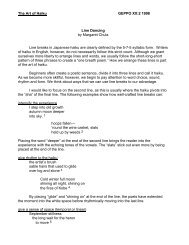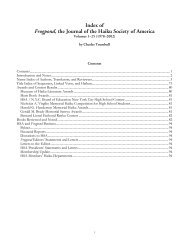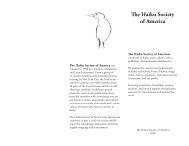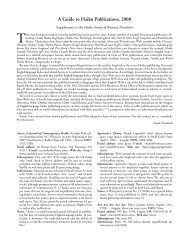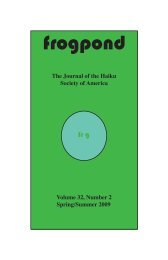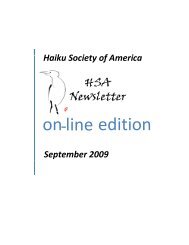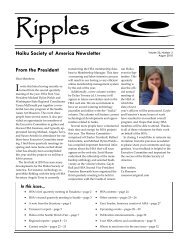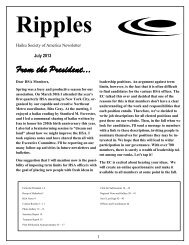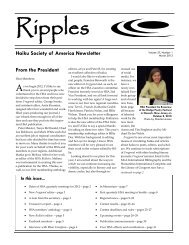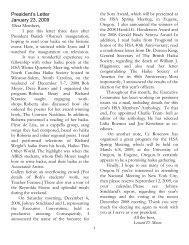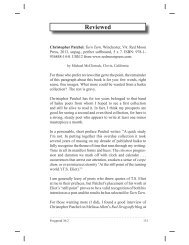Frogpond 34.3 • Autumn 2011 (pdf) - Haiku Society of America
Frogpond 34.3 • Autumn 2011 (pdf) - Haiku Society of America
Frogpond 34.3 • Autumn 2011 (pdf) - Haiku Society of America
You also want an ePaper? Increase the reach of your titles
YUMPU automatically turns print PDFs into web optimized ePapers that Google loves.
Oh elm tree! My destiny is<br />
how you show the shape to grow old with poetry—<br />
<strong>of</strong> noble feeling the autumn nightfall<br />
The elm tree haiku reverberates with Shinto-like appreciation<br />
<strong>of</strong> a tree’s natural form that in some cases might be inhabited<br />
by higher spirit energy. The autumn nightfall haiku reverberates<br />
with Buddhist feeling and the idea <strong>of</strong> transience <strong>of</strong> reality<br />
(autumn is one <strong>of</strong> Ikuya’s favored words in the collection).<br />
Isao discusses in his notes such allusions in some <strong>of</strong> Ikuya’s<br />
haiku within particularly the Zen tradition.<br />
Isao suggests, in fact, that Ikuya is “one <strong>of</strong> the comparatively<br />
few [post-World War II] artists who have secured the continuity<br />
<strong>of</strong> the long-held tradition <strong>of</strong> Japan and its beauty.” 4 Further<br />
he identifies the presiding haikai poetics <strong>of</strong> Ikuya as based on<br />
Edo-furyu. He delineates the characteristics <strong>of</strong> furyu in Ikuya:<br />
. . . being always loyal to one’s own nature beyond advantages<br />
and disadvantages and seeing oneself and reality so<br />
objectively, staying alo<strong>of</strong>, on any occasion, even if one is<br />
in the state <strong>of</strong> the greatest excitement, or faced with one’s<br />
death, as to admire beauty <strong>of</strong> life and nature, rising above<br />
the world . . . 5<br />
Two haiku reflect the furyu connection as a kind <strong>of</strong> nostalgia<br />
for the Edo roots <strong>of</strong> a festival imposed on the present by the<br />
poet and as the cultivation <strong>of</strong> beauty:<br />
one, knowing not alo<strong>of</strong> from the world<br />
the festival <strong>of</strong> Hukagawa beauty is in the haze—<br />
talks about Edo (81) chrysanthemums in the drizzle (83)<br />
Ikuya’s poetics are also language based. Isao points out that<br />
Edo dialect is a “clear and crisp way <strong>of</strong> speaking.” 6 This direct<br />
speech is evident in this haiku:<br />
absent-minded<br />
just grating<br />
a yam (18)<br />
. . . . . . . . . . . . . . . . . . . . . . . . . . . . . . . . . . . . . . . . . . . . . . . . . . . . . . . . . . . .<br />
96 <strong>Haiku</strong> <strong>Society</strong> <strong>of</strong> <strong>America</strong>



